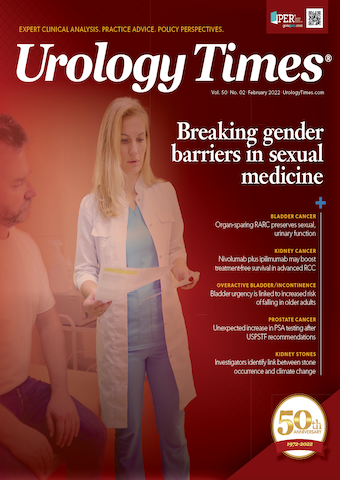Publication
Article
Urology Times Journal
Unexpected increase in PSA testing after USPSTF recommendations
Author(s):
"It is worth remembering that injudicious use of PSA test, and the downstream consequences of overtreatment and complications, can obscure the benefits associated with PSA-based early detection of prostate cancer," writes Badar M. Mian, MD.
Badar M. Mian, MD

Prostate-specific antigen (PSA)-based screening and detection of prostate cancer has remained an active area of research and debate since its widespread utilization began more than 3 decades ago. The imbalance between benefits and harms (overdetection and overtreatment) associated with PSA-based cancer detection, as gleaned from the early results of 2 large trials, resulted in the US Preventive Services Task Force (USPSTF) giving a grade D recommendation in its guideline—ie, recommending against PSA-based screening—in 2012. This quickly and significantly reduced PSA testing and biopsies. Although there was a decrease in overdetection of low-risk prostate cancer, there also were increasing rates of advanced and metastatic prostate cancer over the next few years.
A reassessment of the benefits of PSA-based screening in 2017, supported by long-term data from clinical trials, resulted in an upgrade of the USPSTF recommendations to grade C. The guidance was applicable only to men aged 55 to 69 years, with an individualized decision to undergo periodic PSA-based screening after a discussion of the potential benefits and harms. The USPSTF guidance did not address screening in men younger than 55 years and recommended against PSA-based screening for men 70 years and older. The effect of these changes in recommendations regarding PSA testing or cancer diagnosis is unclear.
A study by Leapman et al sought to evaluate the association between the current USPSTF grade C recommendation and national rates of PSA testing.1 The authors queried the administrative claims database Blue Cross Blue Shield Axis, which provides care to approximately one-third of the privately insured US population. Their goal was to identify patterns of testing in the age group (55-69 years) specifically addressed by the USPSTF guideline as well as among those men who are outside the recommended age range (40-54 years and 70-89 years).
From January 1, 2013, to December 31, 2019, PSA testing trends were studied in male beneficiaries aged 40 to 89 years. The overall median number of eligible beneficiaries for each bimonthly period was 8,087,565, more than 50% of whom were aged 40 to 54 years. The median number of eligible beneficiaries in the group aged 55 to 69 years was 3,372,772, and the median number of men in the group 70 to 89 years was 148,195.
For the entire cohort of patients aged 40 to 89 years, the mean rate of PSA testing increased from 32.5 per 100 person-years in 2016 to 36.5 per 100 person-years in 2019 (P < .001), an absolute and relative increase of 4.0% and 12.5%, respectively. For the groups specified in the USPSTF statement, men aged 55 to 69 years, the mean rate of PSA testing increased from 49.8 per 100 person-years in 2016 to 55.8 per 100 person-years in 2019 (P < .001), corresponding an absolute and relative increase of 6.0% and 12.1%, respectively. Among the group of men aged 40 to 54 years, the mean rates of testing increased from 20.6 per 100 person-years in 2016 to 22.7 per 100 person-years in 2019 (P = .001), an absolute and relative increase of 2.1% and 10.1%, respectively.
For the group of men aged 70 to 89 years, rates of PSA testing increased from 38.0 per 100 person-years in 2016 to 44.2 per 100 person-years in 2019 (P < .001), representing an absolute and relative increase of 6.2% and 16.2%, respectively. The largest absolute increase in PSA testing was noted in the group aged 70 to 74 years (8.2%, P < .001), and relative increases in PSA testing were observed in all subsets of patients 70 years or older.
The data presented by the authors clearly demonstrate that changes in the USPSTF’s prostate cancer screening guideline from a grade D to grade C recommendation (for men aged 55 to 69 years) was associated with an increase in PSA testing in all age groups. Despite maintaining a grade D recommendation (do not screen) in men aged 70 years or higher, this age group demonstrated the largest (up to 16.2% relative) increase in PSA testing. Although no specific recommendations were made for younger men aged between 40 and 54 years, a significant increase in PSA testing was also noted in this group. Whether this increase in PSA testing will reverse the previously reported increased rates of locally advanced and metastatic disease related to insufficient PSA testing remains to be determined.
This raises several clinically relevant questions, including the usefulness of the USPSTF recommendation and how it may affect clinical decision-making regarding PSA testing. It appears that changes to the USPSTF recommendations resulted in unanticipated, wide swings in PSA testing, ranging from insufficient testing after 2012 recommendations to excessive testing following 2017 guidance. Clearly, indiscriminate, population-level screening with the PSA test is inappropriate and harmful due to downstream consequences of overdetection and overtreatment.
A nuanced approach to PSA-based screening requires assessment of life expectancy and a discussion of risks and benefits of screening prior to PSA testing. It is a lot easier to include statements in guidelines regarding proper counseling, and shared decision-making, than it is practical in real life. Who should be responsible for the added requirement of thorough counseling? Should it be the urologists, who tend to favor PSA screening, or the primary care providers, who order the vast majority of screening PSA tests? Regardless, it is safe to state that PSA tests are obtained by both primary providers and urologists without specific or sufficient counseling to satisfy the intent of the guidelines.
It is worth remembering that injudicious use of PSA test, and the downstream consequences of overtreatment and complications, can obscure the benefits associated with PSA-based early detection of prostate cancer. The increased rate of PSA testing and resultant overtreatment increases the number needed to screen and the number needed to treat, potentially diluting the positive impact of PSA testing.
Several advances have been made since the 2012 USPSTF grade D recommendation. Risk calculators, additional biomarkers, genomic tests, multiparametric MRI with targeted biopsy, and increasing adoption of active surveillance have transformed the landscape prostate cancer detection and treatment. What was once thought of as a linear inevitability of PSA test resulting in biopsy, overdetection, overtreatment, and complications has been curbed to a some extent over the past decade. We have the ability to apply the brakes at any of these steps along the PSA screening paradigm to mitigate the harms associated with increased PSA testing.
Reference
1. Leapman MS, Wang R, Park H, et al. Changes in prostate-specific antigen testing relative to the revised US Preventative Services Task Force recommendation on prostate cancer screening. JAMA Oncol. Published online November 11, 2021.. doi:10.1001/jamaoncol.2021.5143


























